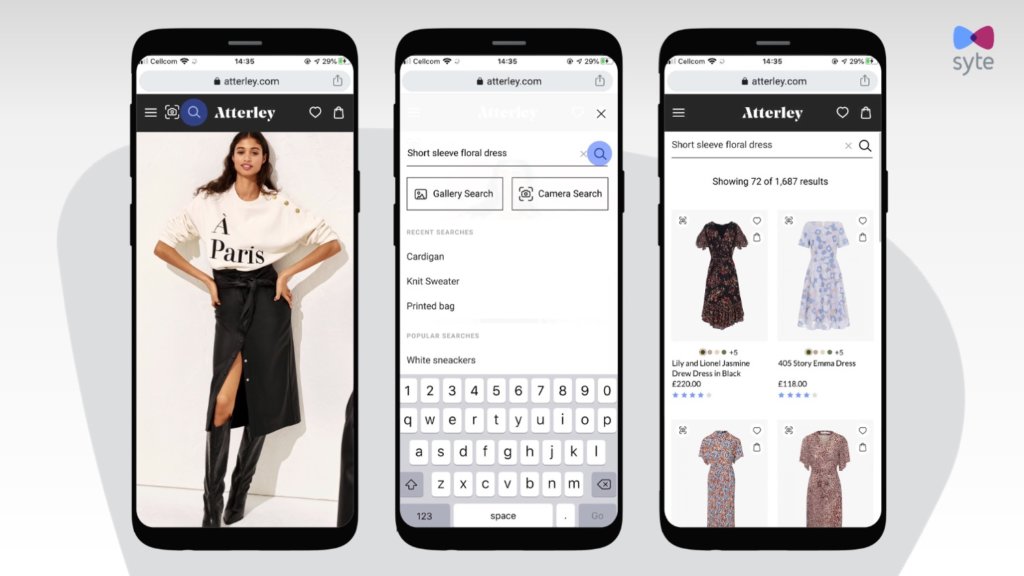The new generation of Textual Search improves the shopping experience with better product search and discovery. How? By deeply understanding customers’ search queries and showing the most relevant results through the power of Deep Tagging.

An overview
Retail has been undergoing a transition, and customer experience has emerged as the key to survival. From “buy online, pick up in-store” to “same-day delivery,” retailers are introducing new tools and services, one after another, to address consumer demands. But there is one persistent dilemma which affects both consumers and retailers that halts the shopping journey at the very moment it starts: Product search.
Behind product search is the tedious inventory tagging which is common for retailers with thousands or millions of stock keeping units from multiple sources including their own. If these items are not tagged accurately and consistently, consumers can’t and won’t find them, leading to missed revenue opportunities. Unfortunately, product tagging is a manual and a very expensive process to do.
This case study demonstrates how Deep Tagging helps brands, retailers, and marketplaces to fill the increasing need for better product search and discovery in eCommerce. Seen through the lens of both consumers and retailers, the discussion looks into the key benefits of the technology to support potential investment in a Deep Tagging solution.
The state of eCommerce today
In the last few years, the retail industry has seen the importance of eCommerce not only as a powerful new channel to engage consumers and drive sales, but also as an engine to expand reach with lower risk and faster results.
By 2021, there will be 2.14 billion digital buyers, and projected global eCommerce sales of USD 4.87 billion, comprising 17.5% of total retail sales worldwide.
“In retail, there is only one battle that matters—the fight for the customer. There are many ways for retailers to differentiate from e-commerce giants, and therefore profitably coexist.” – Thomas O’Connor, Senior Director, Analyst, Gartner
From understanding consumers at a granular level with analytics to enhancing customer experience with AI, there are many ways for retailers to leverage digital capabilities to remain relevant and competitive. But first, a nearly outdated system and practice in eCommerce need to be addressed.
Product search is one of the most basic eCommerce functions, but in the age of AI and personalization, it has yet to advance. Without intuitive product discovery, the gap between inspiration and purchase continues to widen.
The product discovery dilemma
With multiple sources of product inspiration combined with an expectation for immediacy, consumers turn to eCommerce for fast and convenient shopping. Retail Dive revealed that 87% of shoppers start their product search on digital channels.
In addition, Salesforce and Publicis.Sapient conducted a study of 500 million shoppers and 1.4 billion eCommerce visits worldwide. It revealed how fast consumers discover new product types: 75% of consumers conduct brand new site search queries each month.
However, consumer expectation is not being met by eCommerce sites. Shoppers want to be able to search for products and sort through online catalogs easily. But instead, they constantly face the difficulty of not finding the products they have in mind.
“Drilling down into the causes, this pain point is at least partly caused by an inability to identify and find the product. Word-based searches do not lead to the right place and often consumers wouldn’t know the right terminology for the product they search. The challenges are particularly onerous when the customer does not know the name of the brand concerned.” – McKinsey & Co.
Understanding unsatisfactory search experience
For 17 years, the Nielsen Norman Group conducted three studies, monitoring the improvement in eCommerce search. In 2018, the study concluded that search success rates have improved steadily, but still found the following challenges:
- Low-visibility search boxes (for example, behind a tiny magnifying glass icon on a large desktop screen, or hidden under a hamburger menu on mobile)
- Lack of support for typos, errors, or common keyword synonyms
- Nonstandard presentation of results (pagination, sorting, filtering)
- Poorly executed filters (irrelevant attributes, bad functionality, empty result sets)
In relation, a usability study conducted by the Baymard Institute confirmed the “surprisingly dismal support for essential eCommerce search query types.” Here are some of the stunning results:
- 16% of eCommerce sites do not support that users search by product names (which appear on the product page)
- 70% require users to search by the exact product type jargon the site uses
- 22% of the sites don’t support search queries for a color variation (despite the product searched for being available in multiple colors)
- 60% don’t support thematic search queries such as “spring jacket” or “office chair”
- 84% don’t handle queries with subjective qualifiers such as “cheap” or “high quality”
Word-based searches and results are falling behind consumer behavior and expectations. By relying on using the right combination of words or knowing the correct tags or meta tags, both consumers and retailers miss a lot of opportunities to connect. Consumers get frustrated and don’t find the products they are searching for, while retailers fail to deliver a great customer experience that converts.
Tracing the root of the problem
The success of traditional, keyword searches relies heavily on matching the right words to the product tags in the inventory. When consumers use additional qualifiers or different product names or attributes, eCommerce search engines instantly fail to deliver accurate results.
To improve search results, product tags should be consistent, structured, and agile to keep up to date with today’s fast-paced retail consumers. Unfortunately, the process of manually tagging products is a challenge.
- Time-consuming. For retailers and marketplaces with thousands, if not millions, of items from third-party partners including their own, manual product tagging takes so much time and effort that can be directed instead to other parts of the business.
- Expensive. As stock keeping units grow, retailers will need to hire additional people to complete the product tagging. Before that happens, catalogs run the risk of becoming even more disorganized.
- Inconsistent and static. Synchronizing product categories, models, styles, and attributes from multiple sources is a hard, tedious, and close to unattainable task. When products are incorrectly tagged, potential revenues are missed. Manual tagging also has the tendency to get left behind new retail trends.
The result? Poor user search experience and lost sales. But there is a faster and less costly solution.

Deep Tagging for retail
Directly addressing the dilemma of product search and discovery is Visual AI. Visual AI is capable of understanding and labeling the most minute details within an image containing fashion, home décor, and consumer products.
Visual AI is used to power a number of solutions from visual search to recommendation engines. These end user-facing solutions assist with simple product discovery centered around visuals. Deep Tagging uses the same Visual AI technology to enrich a retailer’s catalog with accurate and detailed product tags. This ensures the most accurate textual search for shoppers and the most cost-effective product tagging solution for retailers.
How it works
Using the same technology that powers visual search, Deep Tagging breaks down each element within a retailer’s product image to assign detailed and accurate attribute tags.
What can take a team hours to complete can now be done instantly, and with a clear and detailed lexicon. Whether it is a marketplace receiving feeds from multiple vendors making it close to impossible to unify catalog metadata, or a retailer who requires a full-time team to tag their catalog, Visual AI can solve it.
Enabling tagging in an automated, accurate, and scalable way allows Deep Tagging to give retailers the insights they need and shoppers the textual search experience they expect. In addition, extracting and assigning consistent tags and attributes with superior granularity and consistency from catalog images seamlessly delivers not only accurate but also trendy textual search results.
Eventually, using tags that are continuously updated allow for better predictive analytics and site navigation. See the difference in this example.

All but one of the top textual search results for “gold crossbody” on Walmart.com show a gold crossbody. The rest are a satchel, chain handle, and clutch.

All of the top textual search results for “gold crossbody” on Atterley.com (an enterprise customer of Syte) are relevant products.
The benefits of deep tagging
Leveraging highly structured data improves the accuracy of textual and visual search across retailers’ eCommerce website or mobile app. The following are the key impact of Deep Tagging:
For retailers and marketplaces
- Eliminates the need to manually audit and tag products
- Speeds up the process of tagging products
- Prevents human error
- Streamlines data quality and product categorization especially for retailers and marketplaces with a large inventory sourced from multiple vendors
- Saves time making product list and updating inventory
- Creates an easier seller experience for retailers and marketplaces with a resale unit
- Reduces back-end costs and man-hours
- Supports merchandising and business decisions
For customers
- Ensures accurate search results
- Supports a personalized experience
- Delivers smart product filters
- Saves time searching for the right product
- Eases catalog navigation
- Allows creation of collections based on deep tags
Key results of deep tagging
In numbers, here are some results from Syte’s customers who have implemented Deep Tagging:
- 211% increase in textual search revenue
- 90% decrease in tagging costs
- 8X conversion rate uplift of visual search and textual search
“Our partners give us their catalogs with product tags and descriptions that have their own categorization, models, and styles, making it very difficult to synchronize in a common way for the website. There is a lot of work behind it. Having a functionality like Syte gives us ‘wings’ to increase the number of SKUs or elements that we can incorporate in our catalog.” – Jordi Badia, CIO – CDO Digital Lola Commerce, Venca
Using product images as a source for Deep Tagging is extremely powerful. Images contain a great detail of product information, often more robust than the description itself. With a technology that analyzes each product image, retailers’ inventory and back-end operations become smarter and more open to continuous optimization.
Use cases of Deep Tagging
Once retailers set up Deep Tagging across their online platforms, it will be faster and easier to expand its application. With enriched catalog meta-tagging, retailers can use Syte’s Deep Tagging technology in a lot of ways depending on the kind of experience their consumers expect.
Consistent and updated tags with Image to Text API
Deep Tagging assigns tags to retailers’ image-library automatically, simplifying and enhancing product attribution. As Syte continuously improves the technology, Image to Text API enables retailers to keep their product catalog in-season, culturally adaptable, and agile with a bespoke lexicon of 15,000 tags for trendy consumers.
Now that product tagging is automatic, retailers no longer have to spend hours tagging products, spend money on additional manpower, and deal with outdated product tags.

Intuitive catalog search with Visual Navigation
Gamifying the product search and discovery experience, Deep Tagging allows shoppers to show, instead of explain, what they are looking for. Visual Navigation is an icon-based search tool that enables shoppers to easily filter and find the exact products, eliminating the need to think of the right titles or descriptions.
With this intuitive feature, consumers can narrow down their catalog search until they are left with products that match exactly what they were looking for, maximizing personalization for individual shoppers.
Targeted and accurate results with AI-Powered Textual Search
Say goodbye to blank results due to misspellings and wrong keywords. With Syte’s Deep Tagging, site search results will provide a seamless experience with auto-suggest, spelling correction, and natural language processing capabilities.
As a result, textual product search on retailers’ website or mobile app is enhanced to delight consumers. Retailers, on the other hand, can showcase their products more accurately and with much ease, making sure no potential revenues from poor search results are missed.
Omnichannel product exposure with AI Visual SEO
Consumers search for products anywhere on the web, so retailers need to appear the moment consumers made a search. With AI Visual SEO, retailers can improve search engine ranking and discoverability.
Wherever consumers are coming from and whatever keyword or image search they are making, Deep Tagging will lead them directly to retailers’ website and the relevant product page.
The way forward
From price wars and strategic locations, the differentiation among brands, retailers, and marketplaces today lies in the value created and delivered to customers. Deep Tagging powered by Visual AI and the new and improved Textual Search offer just that.
Simplifying the experience of product search is a powerful and holistic strategy that affects the whole buying journey. By connecting the products to customers looking for them, retailers are bridging the gap between product discovery and purchase.
With Deep Tagging and AI-powered Textual Search, consumers no longer have to deal with the frustrations brought by textual search. Simultaneously, retailers can save on costs and speeds up the lead time of tagging products.
But whether the search is made using an image or keywords, retailers and consumers get the same powerful benefits of convenience, consistency, and customization that Syte’s Deep Tagging and Textual Search technology provides.
“Customers’ expectations are always rising, and sometimes companies struggle to keep up. But by taking the time to invest in new technology and capabilities, companies can rapidly create valuable new customer experiences, manage them cost-effectively and continue evolving them to keep pace with a rapidly changing world.” – Tunde Olanrewaju & Neil Robbins, Digital McKinsey
To know more, check out Syte’s resources for whitepapers, videos, and case studies that educate both consumers and retailers interested in a better visual and textual search experience.